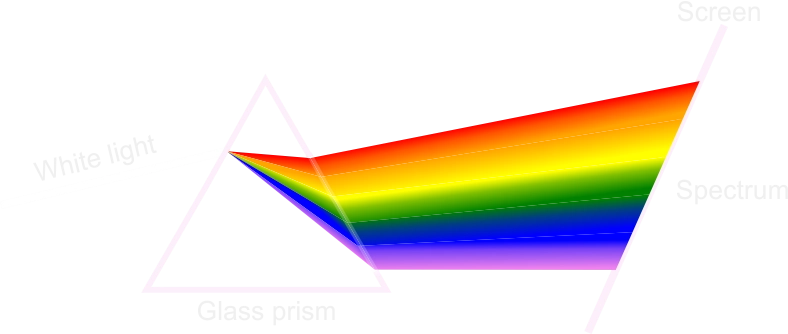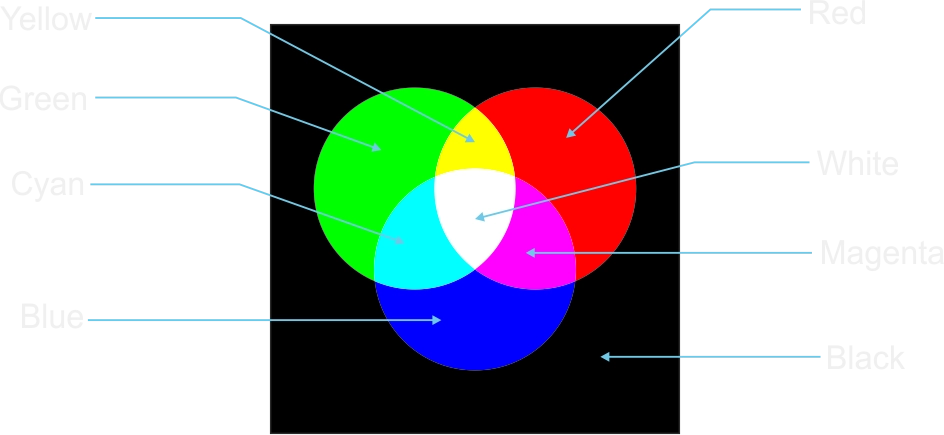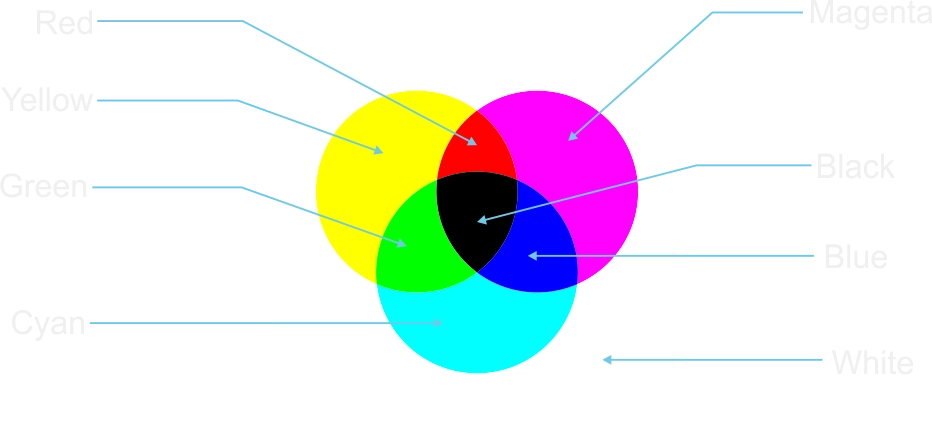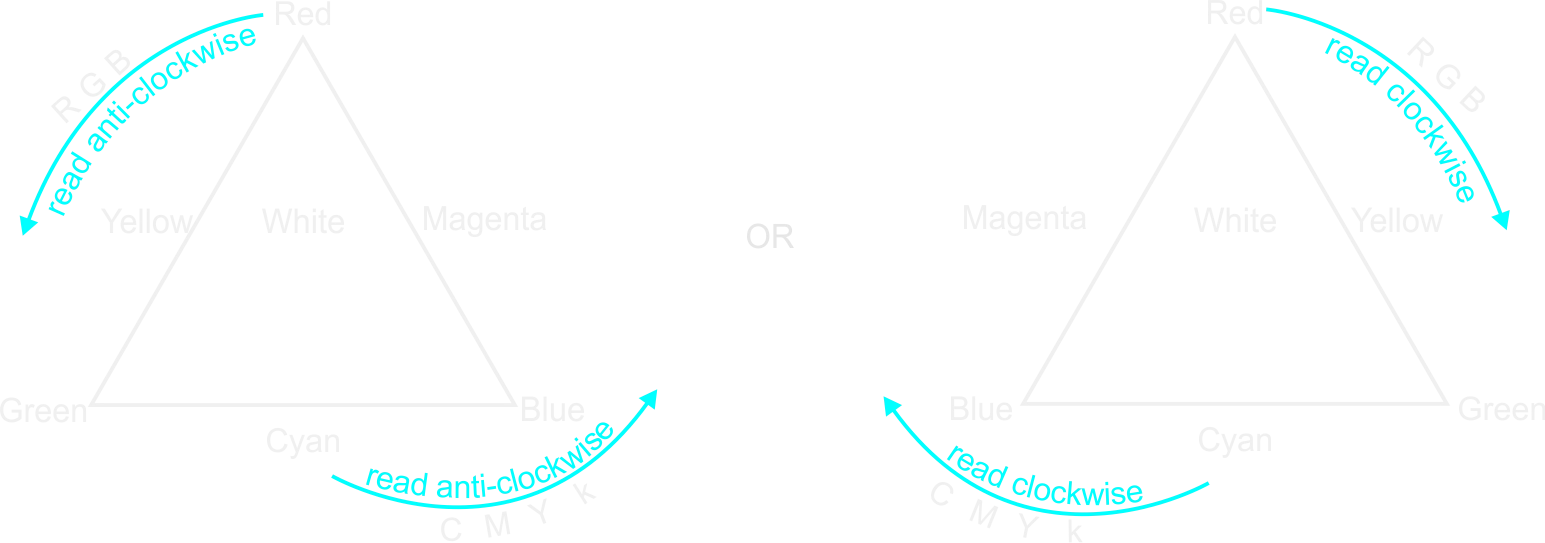Light waves
Dispersion of Light
Theme: Waves-Motion Without Material Transfer
Topic: Light waves
Sub Topic: Dispersion of Light
Date: dd/mm/yyyy
Class: S.S.S 2
Duration: 40 Minutes
No of Learners: 40
Learning Objectives: By the end of the lesson learners should be able to:
1. Defined Dispersion of light
Dispersion of light is the separation of white light into its component colours of red, orange, yellow, green, blue, indigo and violet. spectrum colours
spectrum colours
 Dispersion of white light
Dispersion of white light
White light from a source e.g sunlight, passes through a narrow slit and is incident on the glass prism. After leaving the glass prism, white light is separated into a band or spread of impulse colours which are formed on the screen. The spectrum of white light consists of (bands of) red, orange, yellow, green, blue, indigo and violet colours (ROYGBIV). The separation of the colours by the glass prism is called dispersion. The red colour is deviated least, while the violet colour is deviated most.
MONOCHROMATIC LIGHT: is light of one wavelength nd colour, e.g. Sodim lamp which contain sodium vapour (yellow colour), when such light passes through a prism, refraction occurs without dispersion.
The spectrum shows that red is deviated least while violet is deviated most. It follows therefore that red light travels in glass with the greastest speed while violet travels in glass with the least speed with the order of the apex side A of the glass prism.
 Wide separation of colours
Wide separation of colours
When another identical prism is placed to intercept the refracted rays in the manner shown above, the samearrangement of colours emerge on the screen but with widely seperated colours.
 Production of white light
Production of white light
When the second prism is inverted as shown above, the colours are seen to disapper and only a patch of white light was visible on the screen. This disappearance of the spectrum colours was due to the recombination of the spectrum colours to produce white light.
2. Explain the Production of a pure spectrum
The glass prism separate or dispute the white light into its various colours or wavelengths called the spectrum with different bands of colour overlap (impure spectrum). A spectrum in which such an overlap does not occur is called a pure spectrum. This can be obtained by using an arrangement of converging lenses in addition to the glass prism. Pure spectrum
Pure spectrum
White light from a source passes through a narrow slit and are incident on the first converging lens. The slit is located at the focus of the lens, and hence the white light is rendered parallel after refraction through the lens. Thus, a beam of parallel light is incident on the glass prism. In this way, rays of the same colour will suffer the same amount of deviation by the prism, and each colour will emerge as a parallel beam. They are then brought to focus by the second converging lens. The different colours, red, orange, yellow, green, blue, indigo and violet are then brought to different foci on the screen.
3. Explain COLOUR MIXING
(a) addictive colour mixing (RGB): This are colours of different lights wavelength that are mixed together. If the light of yellow wavelength enters the eye, it sees yellow. However, if a mixture of red and green light wavelenth enters the eye it also sees yellow.(RGB: Red, Green, Blue)
Types of Addictive Colour Mixing
(i) Primary Colour: These are the three basic colours of light from which other colours of light can be produce, which are red, blue and green. All the three primary colours mix together to give white light.
Red + blue + green = white
(ii) Secondary Colours: The colour made by mixing any two primary colours are called secondary colours.
These are:
(1) Red + blue = magenta (Red-blue)
(2) Blue + green = cyan (Blue-green)
(3) Red + green = yellow (Red-green)
(iii) Complementary Colours: This is the combination of Secondary colours of light when primary colours to produces white light.
Cyan is complementary to Red, i.e Cyan + Red = White
Magenta is complementary to Green, i.e Magenta + green = White
Yellow is complementary to Blue, i.e Yellow + Blue = White
 Additive Colour Mixture of Light
Additive Colour Mixture of Light
The operation of colour movies is based on addictive colour mixing.
(b) subtractive colour mixing (CMYK): This is the mixing of colours pigments (such as dy, ink, paint).
An object can only be seen when light is reflected from it into the eye. The substance which gives an object its colour is called a pigment. A pigment absorbs all colours except its own, which it reflects.
A black pigment absorbs all colours and reflects none.
A white pigment reflects all colours.
Coloured objects such as pigments (paints) used by painters can also be mixed together.
Pigment particals are larger than dye molecule and can be seen with a microcope.
Dye are molecule that absorbs certain wavelength of light and transmit or reflect others. E.g, Tomato is red beacause it reflect red and absorbs green and blue lights.
(CMYK: Cyan, Magenta, Yellow, Black ;"key")
Types of Subtractive Colour Mixing
(i) Primary Pigment: A pigment that absorbs only one primary colour from white light and reflect the other two. (Yellow pigment absorbs blue and reflect green and red).
(ii) Secondary Pigment: A pigment that absorbs two primary colours and reflect one. (Red absorbs green and blue, Green absorb red and blue, Blue absorbs red and green).
 Subtractive Colour Mixture of Pigment
Subtractive Colour Mixture of Pigment
A useful way of remembering the ADDITIVE COLOUR OF LIGHT is with the use of the colour triangle. The primary colours are at the corners, the secondary colours are at the sides, the complementary colours are at opposite corners and sides. All the primary, all the secondary, or two complementary colours give white in the center.
 Colour Triangle Additive Colour Mixture of Light
Colour Triangle Additive Colour Mixture of Light
 Colour Triangle Additive Colour Mixture of Light
Colour Triangle Additive Colour Mixture of Light
REMEMBER: Colour miture by addition is the mixture of colour light, while colour mixture by subtractive is the mixture of colour pigment.
The apparent colour of an object depend very much on the quality of light by which it is seen. Objects appear to be a certain colour because the reflect light of that colour only and absord others.
Example
Copy and complete the following table
| S/N | Colour of object on which light is incident | Reflected ray which one sees | Absorbed rays |
|---|---|---|---|
| 1 | Red | Green, Blue | |
| 2 | Blue | Blue | |
| 3 | Green | Green | |
| 4 | Cyan | Red | |
| 5 | Magenta | Red-blue | |
| 6 | Yellow | Blue |
Solution
| S/N | Colour of object on which light is incident | Reflected ray which one sees | Absorbed rays |
|---|---|---|---|
| 1 | Red | Red | Green, Blue |
| 2 | Blue | Blue | Red, Green |
| 3 | Green | Green | Red, Blue |
| 4 | Cyan | Green-blue | Red |
| 5 | Magenta | Red-blue | Green |
| 6 | Yellow | Red-green | Blue |
Rationale:
White light from a source e.g sunlight, passes through a narrow slit and is incident on the glass prism. After leaving the glass prism, white light is separated into a band or spread of impulse colours which are formed on the screen. The spectrum of white light consists of (bands of) red, orange, yellow, green, blue, indigo and violet colours (ROYGBIV). The separation of the colours by the glass prism is called dispersion. The red colour is deviated least, while the violet colour is deviated most.Prerequisite/ Previous knowledge:
Production and propagation of wave.Learning Materials:
Glass prims, lenses, screen, pigment, electric bulbs of different colours.Reference Materials:
1. New School Physic for Senior Secondary Schools, by M. W. Anyakowa.2. Lamlas's SSCE and UTME, by O. Ajaja and H. B. Olaniyi.
3. Okeke P.N and etal (2011), Macminian, Senior Secondary School Physics, New Edition.
4. Farinde E.O and etal (2015), Essential Physics. 6th Edition,
5. New System Physics by Dr. Charles Chow.
Lesson Development:
| STAGE | TEACHER'S ACTIVITY | LEARNER'S ACTIVITY | LEARNING POINTS |
|---|---|---|---|
| STEP I: PREVIOUS KNOWLEDGE full class session |
The teacher asks learners questions based on previous knowledge. 1. What is critical angle? 2. What is total internal refraction? 3. Give one example of total internal refraction in nature. |
Learners' response to teacher's question. 1. This angle of incidence in the denser medium for which the angle of refraction in the less dense medium is 900, is referred to as the critical angle (c), at that point the incidence ray is equal to the critical angle. 2. For angle of incidence greater than critical angle (c), the refracted ray disappears and all the incident light is reflected back into the denser medium. At this point, the ray is said to experience total internal reflection. 3. Example of total internal reflection is the mirage on the road, where the refractive density of warm air is less than that of cool air and light meets a layer at a critical angle, it suffers total internal reflection. |
Confirming previous knowledge. |
| STEP II: INTRODUCTION full class session |
The teacher introduce the topic for discussion. Dispersion of white light White light has a band of wavelengths of different colours. This is called the spectrum colours. Red light has the longest wavelength in air (700 x 10-9m) while violet light has the shortest wavelength (450 x 10-9m) in air. In a vacuum and in air, all the colours of white light travel at the same speed. But in glass, the colours travel at different speeds.Thus, a glass prism can separate or dispute white light into its various colours or wavelengths. |
Learners listen to teacher, ask questions and make contribution. | Developing the idea of the topic, dispersion of white light. |
| STEP III: EXPLORATION Grouping |
The teacher presents the instructional material to the students and divides them into four groups. The representative of a group is asked to discuss the what happens when white light is shone on glass prism and the representative of the other group is asked to point white light through a glass prism. Aim is to show light dispersion. | Learners' expected answer The students carry out the instructions accordingly |
Dispersion of light. |
| STEP IV: DISCUSSION Laws of Refraction |
The teacher guides the students as follow: The separation of white light into different colours by the glass prism is called dispersion. The red colour is deviated least, while the violet colour is deviated most. A spectrum in which such an overlap does not occur is called a pure spectrum. This can be obtained by using an arrangement of converging lenses in addition to the glass prism. All the colours that the eye sees can be made by mixing three basic colours, these three colours, which are called primary colours, are red, blue and green. The colour made by mixing any two primary colours are called secondary colours. These are: (i) red + blue = magenta (ii) blue + green = cyan (iii) green + red = yellow The mixing of coloured lights is known as additive mixing. All the three primary colours mix together to give white light. Red + blue + green = white The mixing of colour pigments is known as subtractive mixing. A pigment is a substance which gives an object its colour. This object can only be seen when light is reflected from it into the eye. A pigment absorbs all colours except its own, which it reflects. A black pigment absorbs all colours and reflects none. A white pigment reflects all colours. |
The students listen, contribute and ask question | Additive colours and subtractive colours. |
| STEP V: APPLICATION | The teacher guides learners to explain colour appearance of an object. | The students explain colour appearance of an object. 1. A white object appears white in daylight because it reflects equally all the colours of the spectrum. 2. A black object in daylight appears black because it absorb all the colours of the spectrum and reflect none. 3. A green leaf appears green in white light because it reflects green but aborbs all the other colours of the spectrum. 4. A primary colour when mixed with an appropriate secondary colour produce white, this is called complementary colours. E.g Green + Magenta = White Blue + Yellow = White Red + Cyan = White |
Appearance of an object. |
| STEP VI: EVALUATION | The teacher asks the learners questions. 1. What is dispersion of light? 2. What is responsible for the dispersion of light as it travelled through the glass prism? 3. What are primary colours 4. What are secondary colours. 5. The combination of all primary colours gives what colour of light? |
The learners expected answers. 1. Dispersion of light is the separation of white light into its component colours of red, orange, yellow, green, blue, indigo and violet. 2. It is due to the fact that the different colours of white light travel at different speeds through the glass. 3. Primary colours are red ,green and blue. 4. Secondary colours are yellow, cyan and magenta. 5. All the three primary colours combined to produce white. |
Ask the learners questions to assess the achievement of the set objectives. |
| CONCLUSION | The teacher concluded the lesson with the students. Coloured filters are made out of coloured glass. A coloured filter transmits its own colour, but absorbs any other colour which falls on it. The operation of colour movies is based on addictive colour mixing. |
The students listen and make contribute | Colour filters and additive colour mixing. |
| ASSIGNMENT | The teacher gives learners a take home. | Theory 1. Explain the term ‘dispersion’ 2. Describe with the aid of a well labeled diagram how a pure spectrum of white light can be produced? Objectives 1. The separation of white light into its constituent colour is known as (a) deviation (b)defraction (c) dispersion (d) deflection 2. The light of one wavelength or colour is called (a) yellow light (b) green light (c) monochromatic light (d) blue light 3. The colours obtained by mixing any two primary colours are called ____ (a) primary colours (b) secondary colours (c) indigo (d) violet 4. In a pure spectrum, what is the function of the lens near the length source? (a) to separate the light colours (b) to produce parallel rays (c) to diverge the light rays (d) to produce dispersion necessary for the spectrum 5. The following colours are primary colours except? (a) Red (b) Green (c)Blue (d) Yellow |
Improving their level of understanding on dispersion of light. |